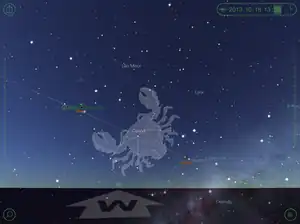Star Walk
Star Walk is an educational astronomy application developed by Vito Technology which allows users to explore celestial objects in real-time through the screen of their devices. The application has been presented within the mobile software market since 2001 and is available for iOS, Android, and Windows. Star Walk has been downloaded by over 10 million users worldwide ever since its release.[1]
 Logo of the Star Walk application | |
| Developer(s) | Vito Technology, Inc. |
|---|---|
| Initial release | for iPhone/iPod Touch: 2008 for iPad: 2011 for Android: 2014 |
| Platform | iOS, Android, Windows |
| Type | edutainment |
| Website | https://starwalk.space/ |
It aims to help beginners in astronomy and students and professionals to locate and identify over 200,000 stars, planets, constellations, and satellites in the night sky and provide detailed information about them.
Functionality

The application helps to determine the exact position of celestial objects in the sky above, calculated in real-time based on the position of the user. It also includes information on star clusters, meteor showers, iridium flares, galaxies, and nebulae as well as the current position of dwarf planets, comets, asteroids, and man-made satellites.[2]
Star Walk utilizes a single-screen dashboard, which shows when the Sun (and other planets which may be visible) rises and sets at a particular location, along with the current moon phase, elevation angle, and day length.
The application also allows users to rewind or fast-forward time to explore the map of the night sky in the past and future. Star Walk uses the iOS device camera for the augmented reality feature, combining the image data from the camera with the star map to give the user a real-time view of celestial objects.[3]
Star Walk 2
Star Walk 2 is an update of the original Star Walk astronomy application. This new version offers a re-designed interface with a variety of camera modes: free roam, manual/scrolling, and augmented reality. The augmented reality view also remains as a holdover from the original app.[4] In order to explore the night sky objects, the user can orient the device toward the sky so that the application activates the camera and the charted objects can be seen appearing superimposed on live sky objects through the use of augmented reality.
Users can scroll a list of objects visible on any night and from any location on Earth.
Release Timeline
Star Walk was launched on November 8, 2008 for the iPhone and the iPod Touch.[5] A version for the iPad was released on March 4, 2010.
Star Walk for Android was released on January 9, 2014.
Star Walk 2 for iOS was released on August 21, 2014. A version of Star Walk 2 for Android devices premiered on March 11, 2015.
As of July 31, 2018, Star Walk became free for all iOS devices.
Reception
In addition to its commercial success, Star Walk has been well-received by critics. At WWDC 2010, Star Walk won an Apple Design Award for the iPad version.[6] In 2012, it won the Parents’ Choice Gold Award in the "Mobile Apps" category,[7] the Academics' Choice Award,[8] and the World Summit Award in the "Entertainment and Lifestyle" category.[9]
| Reviews | ||
|---|---|---|
| Cult of Mac | May 2009 | Lonnie Lazar of Cult of Mac offered to use the application "For stargazing as well as to show off some of my iPhone's capabilities to friends and curious strangers."[10] |
| New York Times | December 2010 | Bob Tedeschi described it as the application that "Will awaken your inner astronomer."[11] |
| RedOrbit.com | March 2012 | Derek Walter of RedOrbit.com recommended it for students and teachers, saying "whether or not you are an astronomy teacher, Star Walk is an immersive app for allowing students to explore the universe."[12] |
| Mashable | January 2013 | News website Mashable confirmed Star Walk received a rating of 4.9 (out of 5) and was number 1 in Top 5 Apps for Kids You Don’t Want to Miss.[13] |
| Soggy Astronomer | February 2013 | "This app brings the old paper star chart into the smart phone age, and makes exploring the night sky easily accessible to everyone."[14] |
| New York Times | March 2013 | Kit Eaton of the New York Times spoke of "The beautiful imagery it uses to show constellations and detail on the planets."[15] |
| TUAW | March 2014 | Mel Martin of TUAW called Star Walk "One of the great demos of Apple technology."[16] |
References
- "10 native apps that give Apple Watch some independence". Cult of Mac. 2015-09-22. Retrieved 2019-09-10.
- Turner, Adam (2014-04-05). "Astronomy apps: Planets v Star Walk". The Sydney Morning Herald. Retrieved 2019-09-10.
- Chen, Jason (5 April 2010). "iPad App Review Marathon Live (Part 2)". Gizmodo.com. Retrieved 2014-03-05.
- "Star Walk 2 mostly improves on the original". Engadget. Retrieved 2019-09-13.
- Team, Vito Technology (Apr 16, 2021). "Star Walk:History of Development". vitotechnology.com.
- Shah, Asam (7 July 2012). "10 incredible iPad apps for education". Thenextweb.com. Retrieved 2014-03-05.
- "Parents' Choice Awards. Star Walk". Parents-choice.org. Archived from the original on 2017-10-22. Retrieved 2014-03-05.
- "Academics' Choice Award™ Winner". Acasemicschoice.com. Retrieved 2014-03-05.
- "Winners of the World Summit Mobile Awards (WSA) 2013 with case studies and 30 videos". mobiForge. 2013-02-11. Retrieved 2019-09-11.
- Lazar, Lonnie. "Cult of Mac Favorite: Star Walk (Mobile App)". Cultofmac.com. Retrieved 2014-03-05.
- Tedeschi, Bob (15 December 2010). "Games and Other Diversions to Turn Into Holiday Gifts". The New York Times. Retrieved 2014-03-05.
- Walter, Derek (16 March 2012). "Best Educational Apps For Students And Teachers". Redorbit.com. Retrieved 2014-03-05.
- Crowell, Chris (13 January 2013). "Top 5 Apps for Kids You Don't Want to Miss". Mashable.com. Retrieved 2014-03-05.
- "The Night Sky In Your Pocket". Soggyastronomer.com. Retrieved 2014-03-05.
- Eaton, Kit (March 2013). "App Smart Extra: Starry Night". Gadgetwise.blogs.nytimes.com. Retrieved 2014-03-05.
- Martin, Mel. "Star Walk still out of this world". Tuaw.com. Retrieved 2014-03-05.
External links
- Star Walk
- Star Walk 2 (official website)
- App Store – Star Walk – Explore the Sky
- App Store – Star Walk HD – Night Sky View
- App Store – Star Walk 2 – Night Sky Map
- App Store – Star Walk 2 Ads+: Sky Map AR
- Google Play – Star Walk – Night Sky Guide: Planets and Stars Map
- Google Play – Star Walk 2 – Sky Guide: View Stars Day and Night
- Google Play – Star Walk 2 Free – Identify Stars in the Night Sky